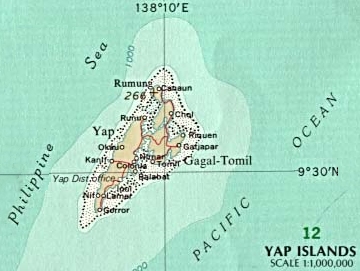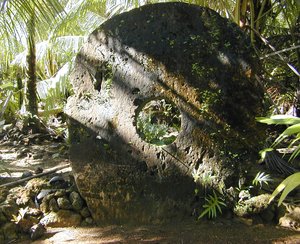Yap
|
|
This article is about the island of Yap. For "Yap" the computer program, see Yap (computer program)
Yap is an island in the Caroline Islands of the western Pacific Ocean, the westernmost state of the Federated States of Micronesia. The "island" of Yap actually consists of four continental islands very close together and joined within a common coral reef and entirety formed from on uplift of the Eurasian plate. The land is mostly rolling hills densely covered with vegetation. Mangrove swamps line much of the shore. An outer barrier reef surrounds the islands, enclosing a lagoon between fringing reefs and the inner edge of the barrier reef.
Colonia is the capital of the State of Yap. It administers both Yap proper and some 130 atolls reaching to the east and south for some 800 km (500 mi). 2003 population was 6,300 in both Colonia and ten other municipalities. The state has a total land area of 102 sq km (38.7 sq mi).
Yap is perhaps the most traditional of the Federated States of Micronesia's four states.
Yap is notable for its stone money, known as Fé (see photograph at left): large donut-shaped, carved disks of (usually) calcite, up to 4 m (12 ft) in diameter (most are much smaller). The islanders know who owns which piece, but do not necessarily move them when ownership changes; their size and weight (the largest ones require twenty adult men to carry) make them very difficult to steal. There are five major types: Mmbul, Gaw, Ray, Yar, and Reng, this last being only 0.3 m (1 ft) in diameter. Their value is based on both size and history, many of them having been brought from other islands, as far as New Guinea, but most coming in ancient times from Palau. Approximately 6,800 of them are scattered around the island. As no more disks are being produced, this ceremonial money supply is fixed (Washington Post, 1984). The United States dollar is the currency used for exchange in Yap.
Yap Proper (known as Wa'ab) was initially settled by ancient migrants from the Malay Peninsula, the Indonesian Archipelago, New Guinea and the Solomon Islands. The Yapese language is related to the Malay languages of Southeast Asia, though with strong New Guinean influences. In contrast, the people of Yap's outer islands are descendants of Polynesian settlers, and as such have significant ethnic dissimilarities from the people of Yap Proper. Their culture and languages (Ulithian and Woleaian) are closely related to those of the neighboring islands of Truk.
The Yapese and outer island Yapese were some of the most renowned navigators in the Pacific. Yapese sailors travelled phenomenal distances in outrigger canoes, without the aid of a compass, navigating by the stars and the patterns of ocean waves. During pre-colonial times, the people of Yap Proper established an island empire and dominion over what are now the outer islands of Yap State. Beginning in the 19th century, Yap was colonized by the Spanish, Germans, and Japanese in succession.
In World War II, Japanese-held Yap was one of the islands bypassed in the US "island-hopping" strategy, although it was regularly bombed by US ships and aircraft, and Yap-based bombers did some damage in return. At the end of World War II, Yap was occupied by the U.S. military victors. The U.S. held it and the rest of the Caroline Islands as a trusteeship under a United Nations mandate (the "Trust Territory of the Pacific Islands") until 1986. In that year, Yap, Truk, Pohnpei and Kusaie formed the independent nation of the Federated States of Micronesia. Under a Compact of Free Association with the United States, Micronesian citizens and goods are allowed entry into the U.S. with few restrictions.
Miscellaneous
Yap is also notable for giant manta rays, which seem to congregate in the waters around the island, and have made it a top scuba diving destination.
A message in a bottle tossed into the Pacific Ocean at Dillon's Beach, north of San Francisco, California, landed on Yap island, as was reported back to the note-tossing children.
External links
- myMicronesia/Yap section (http://www.mymicronesia.com/yap/)
- www.visit-fsm.org/yap (http://www.visit-fsm.org/yap/index.html)
Reference
- Washington Post article of March 29, 1984.de:Yap


